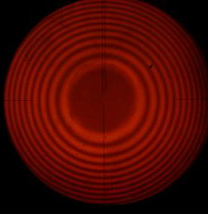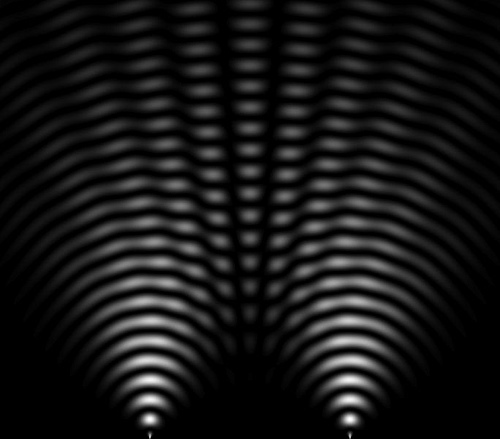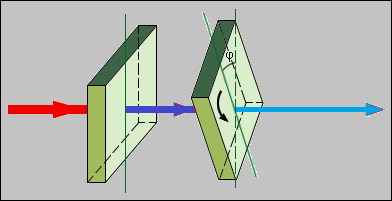Notes to a video lecture on http://www.unizor.com
Light as Waves
Corpuscular theory of light, suggested by Newton, while adequately explaining such properties of light as traveling along a straight line and reflection off the mirror, has not been able to explain certain other properties of light observed by experimentators. In particular, interference, diffraction and polarization of light remained unexplainable in the framework of corpuscular theory.
Attempts to model the light as oscillation of waves were made by several scientists, but the main formulation and explanation of wave-like properties of light is mostly related to a brilliant English physician and physicist Thomas Young.
His famous double-slit experiment, that showed the interference of light passing through two small close to each other slits, convincingly proved that light has wave-like properties.
This experiment is extremely simple, anybody can reproduce it at home, its schema is below.
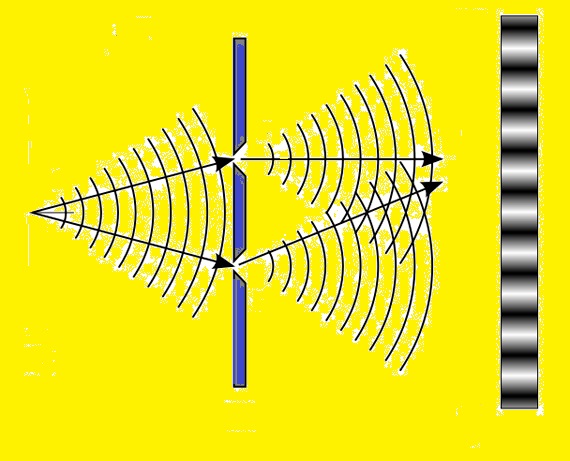
The light from a single monochromatic source equidistant from two slits goes through these slits and is projected on a screen. The picture on the screen is a sequence of light and dark stripes parallel to the slits. This is a picture of interference that can only be explained within a framework of waves.
Two light waves coming through two slits to a surface of a screen in phase (both at its top wave state or both at the bottom) increase each other, making bright stripes. Those that come in opposite phases (one at its top state, while another at the bottom) nullify each other, making dark stripes.
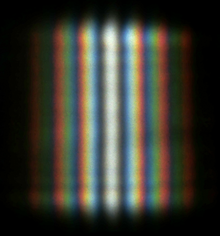
Let's interpret the interference of light from the wave theory viewpoint.
First of all, if light is a wave, we have to determine the carrier of these waves. Until late 19th century physicists accepted a hypothesis that certain substance called ether (or aether) fills all the space and is a material carrier of waves of light and other waves of electromagnetic oscillations.
This hypothesis of ether was later on rejected, but for understanding of wave-like properties of light we can still think about ether as a substance, through which light travels as oscillations of this substance.
It might be considered similar to sound spreading inside a metal object, when you hit this metal object with another one. The crystal structure of the metal will start vibrating at the point of impact (the source of the sound) and these vibrations will spread throughout the whole object in all directions in a form of compression waves.
Notice that in this model the amplitude of vibrations is a characteristic of the strength of the sound and speed of propagation of sound waves depends on properties of material the object is made of.
If light is the waves of a carrier substance, we can talk about this wave's length (distance between two adjacent crests or two adjacent troughs), amplitude (maximum deviation from the neutral position) and speed of propagation (how far a crest moves in a unit of time).
If the speed of light propagation in the ether is c(m/sec) and the wave length is λ, it means that in a 1 sec the crest of a wave moves by a distance c meters. With a wave length λ meters there will be f=c/λ crests on this distance. So, the frequency of oscillation f, that is the number of oscillations per second, the wave length λ and the speed of propagation c are related by the equation
f = c/λ
or
λ = c/f
or
f·λ = c
Let's consider the double slit experiment and analyze what will be observed on the screen at the point equidistant from both slits. Two slits can be considered as two independent sources of light and, considering they are letting through the light emitted by a single source equidistant from them, we can assume that the waves of light are coming in-phase to these slits and go through them also in-phase. Then the two beams of light travel the same distance to a point on a screen that we have chosen as equidistant from the slits, arriving to this point also in-phase. At that point they are combined and intensity of the light is increasing at there. That's why the stripe on a screen in the middle of a picture is bright, it consists of points equidistant from both slits.
If, however, the distance these two beams of light have to travel towards the screen is different, the compounded effect of them, observed on a screen, will be dependent on whether the beams come to a screen in-phase or not.
More precisely, if the difference in the distance these beams travel towards a screen is a multiple of the length of a wave, they will come in-phase, and the overlapping beams will strengthen each other, there will be a bright spot on a screen.
If the difference in the distance equals to a multiple of wave length plus half a wave length, they will come out-of-phase, and the overlapping beams will nullify each other, there will be a dark spot on a screen.
In other cases the effect depends on how close the difference in distance is to a multiple of wave length or a multiple of wave length plus half a wave length with intermediary results.
So, the wave theory can explain the effect of interference. Other wave-related properties of light that can be explained within the framework of the wave theory will be presented in the Optics chapter of this course.
While the corpuscular properties of light do exist, they also can be explained within a framework of the wave theory and the energy of waves. That makes the wave theory of light more universal and more acceptable among physicists, though the auxiliary concept of ether has been totally rejected.
The concept of ether was rejected as there was no experiment that could prove its existence. Moreover, a famous experiment of Michelson-Morley has proven that the speed of light does not depend on the speed of the source of light, which cannot be explained from the position of ether as a medium, through which the light waves propagate.
There were some interesting observations of electric and magnetic properties, which related to an experimental fact that the speed of propagation of electric signals along wires is practically the same as the speed of light. This and other experiments prompted physicists to seek the explanation of the nature of light in the domain of electricity and magnetism.
James Maxwell came up with his famous equations that describe the electromagnetic field and concluded that light is the oscillations of electromagnetic field. There is no special medium, like ether, that carries the light as the sound is carried by the waves of compression of the medium. Instead, the electromagnetic field propagates through space, thus carrying the light.
The properties of electromagnetic field will be presented in the parts of this course dedicated to Electricity and Magnetism.
